

MedFriendly®


Serum
1. Any clear, watery fluid that has been separated from its
more solid parts. For example, when a blister pops, the clear
liquid that comes out is known as serum.
2. The clear, thin, and sticky fluid part of the blood that remains
after the blood has changed from a liquid into a solid form. It is
also known as blood serum. Serum does not contain blood
cells, platelets (cells that help change the blood from a liquid to
solid form), or fibrinogen (a protein in the blood). The part of
blood that contains these and many other types of cells is
known as plasma. Plasma is the fluid component of the
circulating blood that is watery and straw-colored. This is the
difference between serum and plasma.
Serum in a blood vial.
BOOK OF THE DAY: Hematology: Clinical Principles and Applications
3. A clear, watery fluid that wets the surface of thin sheets of tissue (known as serous
membranes) that cover certain openings of the body, such as those in the chest. A clear
watery fluid that oozes out of these tissues is also known as serum.
4. Medications created from the serum (clear, watery fluid) of a person that has greater
than normal protection against a certain poison or infection. These medications work to
produce proteins in the body known as antibodies, which lead to such protection. In this
sense of the word, serum is sometimes referred to as antiserum or antitoxin.
"Where Medical Information is Easy to Understand"™
The plural from of serum is serums or sera. Something that relates, contains, produces, or resembles
serum is known as serous. Serous also means relating to, containing, or producing any substance that
has a watery consistency. For example, if a nurse observed a clear, watery liquid draining from a patient's
wound that is recovering, he/she would likely describe the drainage as serous. Serum is Latin for whey,
which is the watery part of milk.















